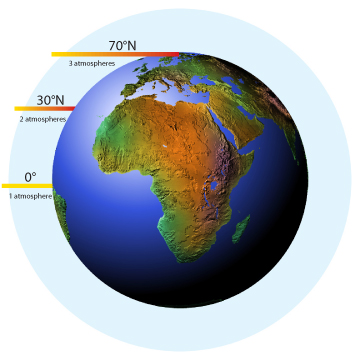There are many factors that contribute to the amount of solar radiation an area on Earth receives. The location on Earth, the time of year, and the weather all play a role in the amount of solar radiation an area receives. The location that receives the most solar radiation per unit area is the Sahara Desert in Africa.
The Sahara Desert is a large, dry, and sunny area that receives a lot of sunlight. The Sahara Desert is also one of the hottest places on Earth. The Sahara Desert receives more solar radiation per unit area than any other location on Earth.
The Sahara Desert is located in North Africa and is one of the driest and hottest places on Earth. It receives the most solar radiation per unit area of any place on Earth. The Sahara Desert is about the size of the continental United States and covers an area of 9.4 million square miles.
The average temperatures in the Sahara Desert range from 86°F to 107°F.
Solar Radiation
Which Location on Earth Receives the Most Solar Radiation?
The Sahara Desert is the world’s hottest desert and receives the most solar radiation. It is located in North Africa and covers an area of 9.4 million square kilometers. The Sahara is a vast, arid region that receives very little rainfall and experiences extremely high temperatures.
During the day, temperatures can reach up to 50°C (122°F) and at night they can drop to below freezing. The Sahara is one of the driest places on Earth with an average rainfall of less than 25 millimeters per year.
Which Part of the Earth Receives the Most Solar Radiation Why?
The part of the Earth that receives the most solar radiation is the equator. This is because the sun’s rays are perpendicular to the surface of the Earth at the equator, and so the sun’s rays hit the Earth’s surface directly. The amount of solar radiation that the Earth receives varies throughout the year, as the Earth’s orbit around the sun is not perfectly circular.
The Earth is closer to the sun in January than it is in July, and so the Earth receives more solar radiation in January than it does in July.

Credit: en.wikipedia.org
Which Receives the Most Solar Radiation
There are many factors that contribute to how much solar radiation an area receives. Some of these include the time of year, the latitude of the location, the angle of the sun, and the presence of clouds or other obstructions.
In general, the areas of the world that receive the most direct sunlight are those near the equator.
This is because the sun’s rays are more perpendicular to the surface of the earth at these latitudes. The time of year also affects how much solar radiation an area receives. For example, the days are longer in the summer, so there is more time for the sun’s rays to reach the earth’s surface.
Cloud cover can have a big impact on how much solar radiation an area receives. Clouds block some of the sun’s rays from reaching the earth’s surface, so areas with more cloud cover typically receive less solar radiation.
There are many other factors that can affect solar radiation levels, but these are some of the most important ones.
So, when you’re wondering which areas of the world receive the most solar radiation, keep these things in mind!
Which of the Following is Not Determined by Hadley Cells?
The answer to this question is not as simple as it might first appear. Hadley cells are a large-scale circulation feature in the tropics that are responsible for the transport of heat and moisture from the equator towards the poles. However, there are a number of factors that can influence the strength and position of Hadley cells, and as a result, it is difficult to say definitively which of the following is not determined by Hadley cells.
Factors that can influence the strength and position of Hadley cells include things like changes in the Earth’s orbit, variations in solar radiation, and differences in the surface properties of the land and ocean. Additionally, the presence of other large-scale circulation features, like the jet streams, can also play a role in shaping Hadley cells.
Ultimately, because there are so many factors that can influence the strength and position of Hadley cells, it is difficult to say definitively which of the following is not determined by Hadley cells.
However, it is safe to say that Hadley cells are a major player in the large-scale circulation of the Earth’s atmosphere and play a significant role in determining the climate of the planet.
In What Form is Radiation Emitted from the Earth’S Surface Back into the Atmosphere?
Radiation is emitted from the Earth’s surface back into the atmosphere in the form of infrared radiation. This radiation is invisible to the naked eye but can be detected by instruments. It is a type of electromagnetic radiation with a long wavelength that is absorbed by greenhouse gases in the atmosphere.
Greenhouse gases trap heat in the atmosphere and cause the Earth’s surface to warm.
Conclusion
The Sahara Desert in Africa is the sunniest place on Earth. It gets more direct sunlight than any other place on the planet. The Sahara is also the hottest desert on Earth.
Temperatures there can exceed 104 degrees Fahrenheit (40 degrees Celsius).
